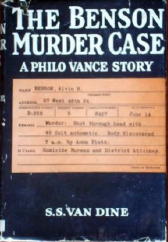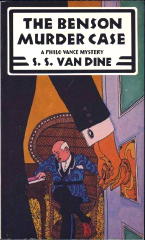Fri 18 Jul 2008
A Review by Mary Reed: S. S. VAN DINE – The Benson Murder Case (Take 2).
Posted by Steve under Authors , Characters , Reviews1 Comment
S. S. VAN DINE – The Benson Murder Case. Charles Scribner’s Sons, 1926. Hardcover reprints include: A. L. Burt, no date (shown); Gregg Press, 1980. Paperback reprints include: Pocket #333, 1945 (shown); Fawcett Gold Medal T2006, no date (ca.1968); Scribner’s, 1983 (shown).

Narrator ‘Van’ Van Dine originally met Philo Vance at college and is now not only a close friend but also his full-time legal and financial advisor. He is thus on the spot to record cases in which Vance becomes involved.
Vance is rich and cultured, possessing many beautiful and rare examples of art and artefacts from various eras and continents. He easily out-Wimseys Wimsey, what with addressing people as ‘Old dear’ and constantly talkin’ ragin’ nonsense, often dropping French or German into conversations with an occasional bit of Latin for variety, not to mention quoting luminaries such as Milton, Longfellow, Cervantes, and Rousseau as well as Spinoza and Descartes. But it’s all a front, of course.
John Markham, DA for NY County, arrives at Vance’s flat while Van and Vance are discussing business and announces wealthy broker Alvin Benson has been murdered. Alvin’s brother Major Anthony Benson has asked Markham to take charge, and Markham had promised Vance he would take him along on his next important investigation. It seems the authorities were casual about protocol as well as crime scenes, because not only do both Vance and Van tag along but they are also present at several interrogations.

At one point Vance produces a list of suspects based upon reasoning from available information and physical evidence. The only snag is they are innocent. It is a demonstration of his conviction that “The truth can be learned only by an analysis of the psychological factors of a crime and an application of them to the individual”.
Who then is the culprit? The actress Muriel St Clair, in whom the dead man had taken more than a passing interest? Her fiance Captain Philip Leacock, he of the hasty temper and jealous disposition? Major Benson, given the brothers did not get along? What about Mrs Anna Platz, Alvin’s housekeeper, who seems to be hiding something, or the precious and impecunious Leander Pfyfe, a close friend of the deceased?
My verdict: Some will find Vance’s insistence on keeping the identity of the murderer secret irritating but given he had it sussed out within an hour or two of visiting the crime scene, one can see why.

To be fair, he all but takes Markham’s hand and leads him to the culprit. There are clues aplenty, and to my delight the author provided those much-loved and now sadly missed tidbits — a room plan, a character list, and footnotes from Van.
Although readers may find Vance’s lit’r’y meanderin’s a bit tedious, his explanation of his psychological reasonings are interesting and convincing, although I am still not certain if the author was sending it up or using it as a genuine plot device. All in all, however, a good read with plenty of red herrings to confuse the issue.
Etext:
http://gutenberg.net.au/ebooks02/0200341h.html
[EDITORIAL COMMENT.] Mary sent me this review back in September of ’07, along with a backlog of others. (Sorry, Mary!) I’ll get more of them online here soon, but after posting Bill Loeser’s recent comments about the same book, I thought I ought to pull this one out of the queue and give it some priority, the idea being that two independent views of a book are better than one, and certainly far better than none. (Where else has The Benson Murder Case been reviewed in the last 10 or 20 years?)
That’s a rhetorical question. You needn’t answer it.
January 23rd, 2009 at 9:59 pm
I always felt there was a playful element in the Vance books, and it would seem to fit with what I know of Wright’s character. The difference between Vance and Wimsey is that Vance’s knowledge of the arts and sciences is quite real, Wright a noted art critic, while Sayers was well educated but hardly the renaissance figure Wright was. When Wimsey indulges in antiquities it’s reasearch and wishful thinking, when Vance does so he speaks with the weight of actual experience and learning.
If you like the Vance books you might look up a book called the John Riddell Murder Case by Corey Ford that is something of a send up of the Vance novels and The Smiling Corpse by Anonymous (Philip Wylie) where a New York detective at a literary luncheon matches wits with Dashiell Hammett, Sax Rohmer, and S.S. Van Dine when a murder occurs. With that trio there is a notable amount of drinking to be done as well as detecting.
Of the later Vance novels The Kidnap Murder Case was interesting in that Vance gets involved in a high speed car chase and running gun battle, and The Gracie Allen Murder Case for the odd teaming of the radio star and the detective. Winter Murder Case is the scenario for a Vance film that was never made, but somehow ended up filmed as a musical according to some sources. Probably the most entertaining of the books is The Bishop Murder Case wherein the killer is using nursery rhymes as the theme to his crimes and the solution involves a dense book on criminology in German, heavy water, physics, and German opera.
Many people find the Vance books annoying (“Philo Vance need a kick in the pants” as Ogden Nash wrote), but I’ve always found them to be fun, a sort of game in the tradition of the genre’s origins in the Golden Age. I will mention that if you read many of the books you will find that the killer always makes his appearance on the same page, but you can find out on which page for yourself.
Also, Wright plays detective in Max Allan Collins The Lusitania Murders, an entertaining entry in his series of novels set at modern disasters with real life writers as the sleuth.